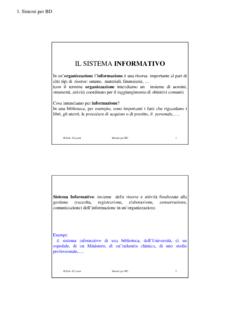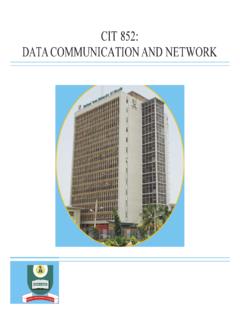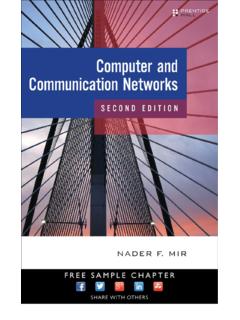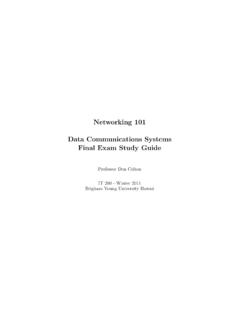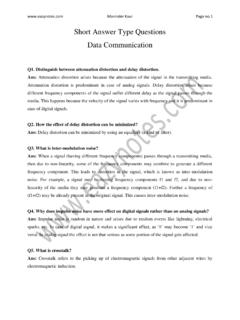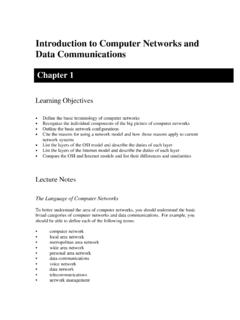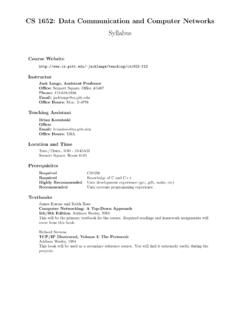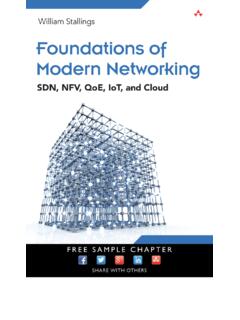Transcription of DATA COMMUNICATION - Dipartimento di Informatica
1 ALTTC/NP/KKD/ data (NP-II)ALTTCDATA COMMUNICATION (Basics of data COMMUNICATION ,OSI layers.)ALTTC/NP/KKD/ data Communication2 data Communications History 1838: Samuel Morse & Alfred Veil Invent Morse Code Telegraph System 1876: Alexander Graham Bell invented Telephone 1910:Howard Krum developed Start/Stop SynchronisationALTTC/NP/KKD/ data Communication3 History of Computing 1930: Development of ASCII Transmission Code 1945: Allied Governments develop the First Large Computer 1950: IBM releases its first computer IBM 710 1960: IBM releases the First Commercial Computer IBM 360 ALTTC/NP/KKD/ data Communication4 Main Contributors of data Comm.
2 Transmission Technology Packet Switching Technology Internet 1967: ARPANET by Advanced Research Project Agency (ARPA) of 1975: TCP/IP protocol LAN Technology DIX-Ethernet & IEEE 802 Networks WAN 1976: ISO releases HDLC & CCITT releases (PSPDN)ALTTC/NP/KKD/ data Communication5 Various Networks Home Area Network (HAN) Local Area Network (LAN) Metropolitan Area Network (MAN) Wide Area Network (WAN) Global Area Network (GAN)ALTTC/NP/KKD/ data Communication6 Voice & data In 70 s & 80 s main thrust in Wide Area networking (WAN) was to put data on Voice Circuitsusing Modem & on ISDN lines In 90 s the trend is reverse.
3 Major Efforts were on putting Voice Over data using: Voice Over Frame Relay Voice Over Internet Voice Over ATM etcALTTC/NP/KKD/ data Communication7 What is data Communications? Exchange of digital information between two digital devices is data communicationALTTC/NP/KKD/ data Communication8 networking networking is the convenient way of making information accessible to anyone, anytime & anywhere. Evolution of networking Computers handling Large data were developed viz. text, graphics,animation, sound & video Improvements in Personal Computers Small, powerful & cheap user friendly systems. Emergence of Computer Networks Distributed, Intelligent, High-speed LAN/WANALTTC/NP/KKD/ data Communication9 What is Interoperability ?
4 The Capability of two or more computers of different vendors to transmit & receive data and to carry out processes as expected by the user is called ComputerAT &T ComputerALTTC/NP/KKD/ data Communication10 Requirements of data Communications At least Two Devices ready to communicate A Transmission Medium A set of Rules & Procedure for proper COMMUNICATION (Protocol) Standard data Representation Transmission of bits either Serial or Parallel Bit synchronisation using Start/stop bits in case of Asynchronous Transmission In Synchronous Transmission the agreed pattern of Flag Signal encoding rules viz. NRZ or RZ And other higher layer protocolALTTC/NP/KKD/ data Communication11 data Representations A group of bits are used to represent a character/number/ special symbol/Control Characters 5-bit code can represent 32 symbols (25=32) 7-bit code can represent 128 symbols (27=128) & 8-bit code can represent 256 symbols (28=256)ALTTC/NP/KKD/ data Communication12 Code Set A code set is the set of codes representing the symbols Very common code sets are : ASCII.
5 This is ANSI s 7-bit American Standard Code for Information Interchange ASCII code(7-bit) is often used with an 8thbit known as parity bit used for detecting errors during data Transmission Parity bit is added to the Most Significant bit (MSB) EBCDIC: this is IBM s 8-bit Extended Binary Coded Decimal Interchange CodeALTTC/NP/KKD/ data Communication13 ASCII Code ASCII is defined in ANSI Corresponding CCITT recommendation is IA5 (International Alphabet ) ISO specification is ISO 646 Total 128 codes 96 codes are graphic symbols (in Col. 2~7). 94 codes are printable And 2 codes viz. SPACE & DEL characters are non printable 32 codes control symbols (Col.)
6 0 & 1) All are non printableALTTC/NP/KKD/ data Communication14 EBCDIC Code It is an 8-bit code with 256 symbols No parity bit for error checking The graphic symbols are almost same as ASCII Several differences in Control characters as compared to ASCII ALTTC/NP/KKD/ data Communication15 Baudot Teletype code It is a 5-bit code also known as ITA2 (International Telegraph Alphabet No. 2). 32 codes are possible. With the help of Letter shift & Figure shift key same code is used to represent two symbols. Maximum symbols in this code are 58 Used in Telegraphy/TelexALTTC/NP/KKD/ data Communication16 data Transmission data Transmission means movement of the bits over a transmission medium connecting two devices Two types of data Transmission are: Parallel Transmission Serial TransmissionALTTC/NP/KKD/ data Communication17 Parallel Transmission In this all the bits of a byteare transmitted simultaneously on separate wires.
7 Practicable if two devices are close to each other Computer to Printer, COMMUNICATION within the ComputerTransmitter001120304150617100 Receiver00110000111111 ALTTC/NP/KKD/ data Communication18 Serial Transmission Bits are transmitted one after the other Usually the Least Significant Bit (LSB) has been transmitted first Serial Transmission requires only one circuit interconnecting two devices Suitable for Transmission over Long distance LSB11010010 MSBT ransmitterReceiver11000011 ALTTC/NP/KKD/ data Communication19 What is a Bit Rate ? Number of bits that can be transmitted in 1 second If tpis the duration of the bit then the Bit rate R= 1/tp Bit duration need not be same as the pulse durationALTTC/NP/KKD/ data Communication20 Receiving data bits Received Signal is never same as transmitted Clock signal samples & regenerates the original bits as it was transmitted Received Signal should be sampled at right instant.
8 Otherwise it will cause bit error Transmitted SignalRecovered SignalSampled SignalClock SignalReceived Signal1100001111000011 ALTTC/NP/KKD/ data Communication21 Modes of Transmission Two methods for Timing control for receiving bits Asynchronous Transmission Sending end commences the Transmission of bits at any instant of time No time relation between the consecutive bits During idle condition Signal 1 is transmitted Start bit before the byte and Stop bit at the end of the byte for Start/Stop synchronisation Synchronous Transmission is carried out under the control of the timing source No Start/Stop bits Continuous block of data are encapsulated with Header & Trailer along with FlagsALTTC/NP/KKD/ data Communication22 Asynchronous TransmissionNote.
9 Start bit is always 1 bit durationStart bit is always equal to 0 Stop bit may be 1 or or 2 bits durationStop bit is always equal to 1 Idle period time is arbitrary (variable)Direction of Transmission11000011 Start bitStop bitIdleIdle11000011 Start bitStop bitStart- Stop SynchronisationALTTC/NP/KKD/ data Communication23 Synchronous Transmission Flag identifies the Start and End of the block Receiver first detects the Flag (usually a fixed pattern) and then detects the other bits/bytes in the data field Complete Block along with the Flags is called a FRAMEB lock Of bytesFlag Flag Idle data Block Of bytesFlag Flag Block 2 Block 1 Direction of TransmissionALTTC/NP/KKD/ data Communication24 Signal Encoding For transmission of bits into electrical signals for two binary states simple +ve and ve voltages are not sufficient.
10 Sufficient Signal transition should be present to recover the clock properly at the receiving end Bandwidth of the signal should match with transmission medium Several ways to represent the bits as electrical signals Two broad classes are: Non-Return to Zero (NRZ) and Return to Zero (RZ) ALTTC/NP/KKD/ data Communication25 Non Return to Zero (NRZ) Codes00111001 Clock SignalNRZ-L Coding ( data Bits)NRZ-M CodingNRZ-S CodingNRZ-L :Non-Return to Zero Level (coded according to binary values of the data bits)NRZ-M :Non-Return to Zero on Mark (Voltage Transition takes place on Mark (1)NRZ-S :Non-Return to Zero on Space (Voltage Transition takes place on Space (0)ALTTC/NP/KKD/ data Communication26 Return to Zero (RZ) Codes If there is continuous string of 0 s or 1 s in NRZ code it is very difficult to recover the clock signal Hence Return to Zero code (RZ) was implemented Clock can be extracted from the Return to Zero code by the receiver using lot of transitions RZ signals are the combination of NRZ-L Signal + Clock Signal Various RZ codes are.))
